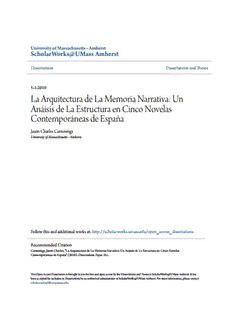
La Arquitectura de La Memoria Narrativa: Un Anáisis de PDF
Preview La Arquitectura de La Memoria Narrativa: Un Anáisis de
UUnniivveerrssiittyy ooff MMaassssaacchhuusseettttss AAmmhheerrsstt SScchhoollaarrWWoorrkkss@@UUMMaassss AAmmhheerrsstt Open Access Dissertations 5-2010 LLaa AArrqquuiitteeccttuurraa ddee LLaa MMeemmoorriiaa NNaarrrraattiivvaa:: UUnn AAnnááiissiiss ddee LLaa EEssttrruuccttuurraa eenn CCiinnccoo NNoovveellaass CCoonntteemmppoorráánneeaass ddee EEssppaaññaa Jason Charles Cummings University of Massachusetts Amherst Follow this and additional works at: https://scholarworks.umass.edu/open_access_dissertations Part of the Spanish Linguistics Commons, and the Spanish Literature Commons RReeccoommmmeennddeedd CCiittaattiioonn Cummings, Jason Charles, "La Arquitectura de La Memoria Narrativa: Un Anáisis de La Estructura en Cinco Novelas Contemporáneas de España" (2010). Open Access Dissertations. 241. https://doi.org/10.7275/1557558 https://scholarworks.umass.edu/open_access_dissertations/241 This Open Access Dissertation is brought to you for free and open access by ScholarWorks@UMass Amherst. It has been accepted for inclusion in Open Access Dissertations by an authorized administrator of ScholarWorks@UMass Amherst. For more information, please contact scholarworks@library.umass.edu. LA ARQUITECTURA DE LA MEMORIA NARRATIVA: UN ANÁLISIS DE LA ESTRUCTURA EN CINCO NOVELAS CONTEMPORÁNEAS DE ESPAÑA A Dissertation Presented by JASON C. CUMMINGS Submitted to the Graduate School of the University of Massachusetts Amherst in partial fulfillment of the requirements for the degree of DOCTOR OF PHILOSOPHY MAY 2010 Hispanic Literatures, Cultures and Linguistics © Copyright by Jason C. Cummings 2010 All Rights Reserved LA ARQUITECTURA DE LA MEMORIA NARRATIVA: UN ANÁLISIS DE LA ESTRUCTURA EN CINCO NOVELAS CONTEMPORÁNEAS DE ESPAÑA A Dissertation Presented by JASON C. CUMMINGS Approved as to style and content by: _______________________________________ Barbara Zecchi Chair _______________________________________ Luis Marentes, Member _______________________________________ Justin Crumbaugh, Member _____________________________________ Francisco Fagundes, Program Director Hispanic Literatures and Linguistics Program Department of Languages, Literatures and Cultures _____________________________________ Julie Candler Hayes Department Chair Department of Language, Literatures and Cultures DEDICATION To my wife, Christy, and to my parents for all of the love and support with which they have sustained me. ACKNOWLEDGMENTS I would like to thank Professor Barbara Zecchi for all of her patience, kindness and for the sage advice that she has given me during my years as a graduate student. Without her countless hours of reading, commenting and revising, this project would have been insurmountable. Her many, many responses to my e-mails, and her willingness to support me in both academic and administrative matters have made it possible for me to complete this degree largely from a distance. Also, I owe a debt of gratitude to Professor Luis Marentes and to Professor Justin Crumbaugh for generously offering their time to serve on my dissertation committee. Their comments and suggestions have been an extraordinary help to me in revising and polishing this study. v ABSTRACT LA ARQUITECTURA DE LA MEMORIA NARRATIVA: UN ANÁLISIS DE LA ESTRUCTURA EN CINCO NOVELAS DE LA CONTEMPORANIEDAD ESPAÑOLA MAY 2010 JASON C. CUMMINGS, B.A., COLBY COLLEGE M.A., MIDDLEBURY COLLEGE PH.D., UNIVERSITY OF MASSACHUSETTS AMHERST Directed by: Professor Barbara Zecchi The current study contemplates the relationship between narrative structure and memory in five contemporary Spanish novels. Since the Spanish Transition to Democracy literary critics have been quick to discuss the resurgence of historical memory in narrative. In particular, there has been an abundance of work that seeks to vindicate those who supported the Second Republic during the Spanish Civil War, but whose voices were silenced upon the republic‘s fall to Franco‘s army in 1939. Nevertheless, despite the wide critical recognition of a movement to recuperate Spanish historical memory, critics have largely ignored the role played by narrative structure in the construction of said memory during the 1990‘s and the first decade of the 21st century. Contemplating what Hayden White calls ―the content of the form‖ at the stylistic level as well as at the level of each novel‘s macrostructure, this study demonstrates that the narrative techniques utilized by Juan Marsé, Manual Rivas, Dulce Chacón, Javier Cercas and Bernardo Atxaga cast a particularly postmodern light onto the darker mnemonic shadows of the Spanish Civil War and Franco‘s dictatorship. Through a series vi of typically postmodern mechanisms, such as the use of multiple narrators, mediated texts and constant dialog between varying levels of fiction and metafiction, these narratives transcend mere historic reflection and nostalgia in order to contemplate the subjective nature of the very mnemonic processes through which they are ostensibly created. The narrative structures of the works discussed in this study emphasize the fact that objective truth cannot be attained by means of present, postmodern remembering, much less when said remembering is linguistically mediated through narration. Thus, rather than seeking in vain to recuperate an unascertainable historical truth, these authors create highly structured, though purely esthetic, fictional representations of history, representations whose narrative forms are a prescription for the epistemic ills of the disillusioned, fragmented and uprooted postmodern implicit reader. vii ÍNDICE DE MATERIAS Página ACKNOWLEDGMENTS ...................................................................................................v ABSTRACT ....................................................................................................................... vi LISTA DE FIGURAS ..........................................................................................................x INTRODUCCIÓN ...............................................................................................................1 CAPÍTULO 1. JUAN MARSÉ- RENEGANDO DE LA VERDAD VERDADERA ...........................21 Las voces trenzadas....................................................................................24 Sin punto de partida: el desarraigo y la falta de orígenes ..........................39 La simetría actancial .................................................................................47 Algunas conclusiones.................................................................................53 Bibliografía ................................................................................................57 2. MANUEL RIVAS O EL CURANDERO DE SOMBRAS ...........................................58 Una entrevista con el doctor: La focalización dialógica de Sousa .............65 El problema del origen del texto (más voces trenzadas) ............................69 La reproducción s(t)ex(t)ual y el rectángulo semántico ............................77 La catarsis de la creatividad .......................................................................86 Algunas conclusiones: Otra vez al centro ..................................................91 Bibliografía ................................................................................................99 3. DULCE CHACÓN: HACIENDO LO BLANCO NEGRO .........................................101 El porqué de los motes ............................................................................106 La historia y la memoria: una novela bipolar ..........................................117 Otra novela dialogada ..............................................................................124 Algunas conclusiones...............................................................................142 Bibliografía ..............................................................................................152 viii 4. JAVIER CERCAS EN BUSCA DE UNA AUSENCIA .............................................154 El autor implícito y el narrador-protagonista ...........................................158 Forma, felicidad y ficción ........................................................................167 Conchi y Aguirre vs. el relato real ...........................................................170 La dialéctica española – Lo ideal, lo material y lo estético .....................180 Algunas conclusiones...............................................................................189 Bibliografía ..............................................................................................192 5. BERNARDO ATXAGA Y EL FUELLE TEXTUAL................................................194 Para terminar, otro punto de partida ........................................................198 La narrativa mediada y el mito del héroe.................................................210 Algunas conclusiones...............................................................................231 Bibliografía ..............................................................................................235 BIBLIOGRAFÍA .............................................................................................................237 ix
Description: